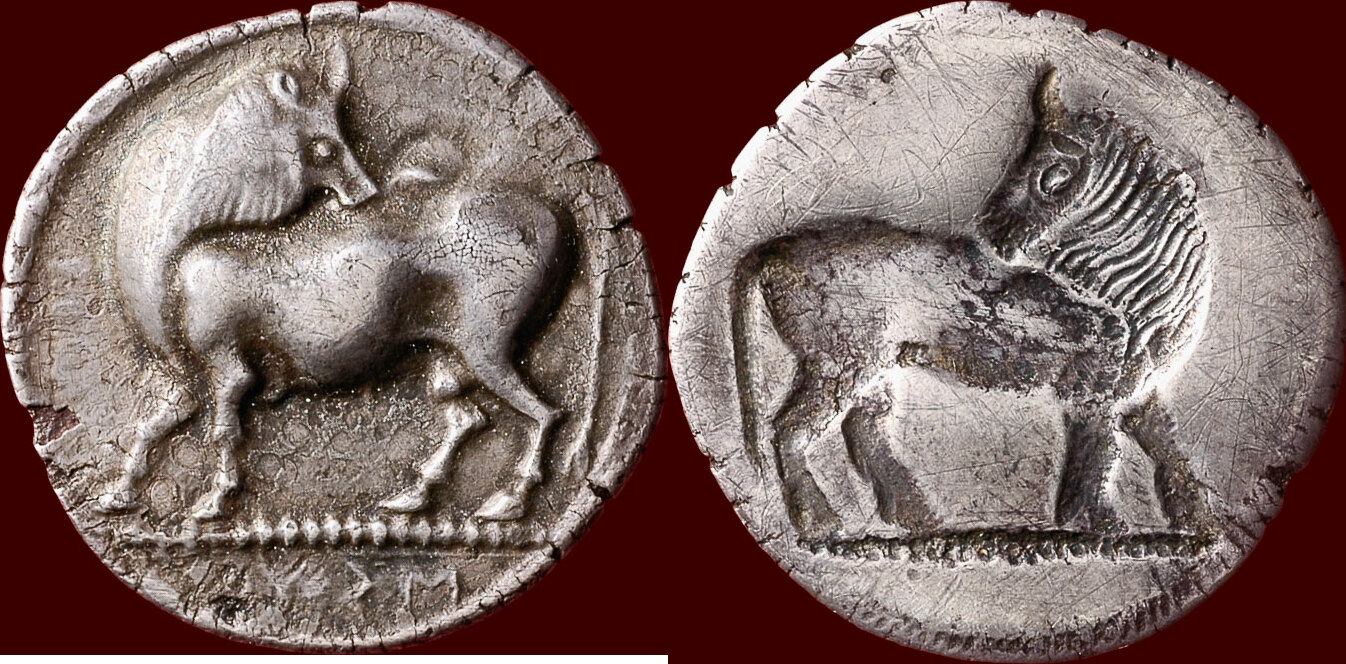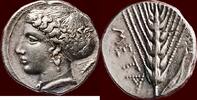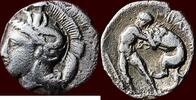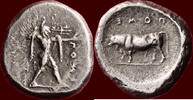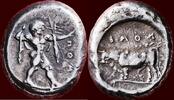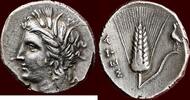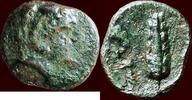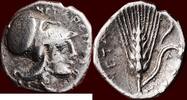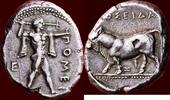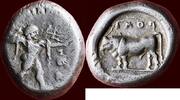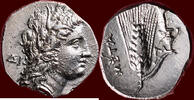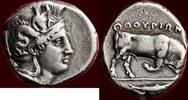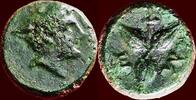MA-ID: 7013602010
Bewertungen Henzen
Schnelle Lieferung. Super Ware. Vielen Dank!
O.K.
perfekt !!!
Great coin, quick delivery, thanks!
540-510 BC v. Chr. LUCANIA - SIRINOS - AR Nomos or tridrachm, circa 540-510 BC (ex. Rosen Collection) alliance stater of Sirinos & Pyxis), lot 503 in vz : CHF 110.000+17,5%)
Munthandel G.Henzen 

10
Seit 10 Jahren bei MA-Shops
7244 Bewertungen,
100 % Positiv (seit 24 Monaten)
Weltweiter Versand
45000,00 EUR
Differenzbesteuert nach §25a UStG
zzgl. 18,00 EUR Versand ( nach Deutschland )
Lieferzeit: 5 - 8 Tage*
zzgl. 18,00 EUR Versand ( nach Deutschland )
| Bestellhotline +49 (0)2871 2180 383 |
| Zahlungsarten |
| Überweisung |
alliance stater of Sirinos & Pyxis), lot 503 in vz : CHF 110.000+17,5%) | Abkürzungen
BMC 1-2var. | SNG.ANS.- (cf.816) | SNG.Copenhagen- (cf.1387) | SNG.München- (cf. 1153var. | Jameson Coll.- (cf.344) | Gorini- (cf. 2) | Rosen Collection 14 (this coin) |
27,00 mm
weight 8,10gr. | silver Ø 27mm.
obv. Bull walking left, looking backwards,
ΣIPIN retrograde in exergue (in archaic characters)
rev. Incuse bull standing right, looking backwards. No text.
The unusual fabric of this piece follows a style peculiar to Greek southern Italy in the archaic period: A broad, thin flan, obverse depicted in relief, the reverse repeating the obverse motif but in negative relief, or incuse, and reversed. Creating such coins required a high degree of technical skill and quality control. The reasons for the popularity of this fabric are poorly understood some scholars have postulated a connection to the mathematician-philosopher Pythagoras, who was active in Italy during this period and taught a creed which stressed the duality of mankind′s nature and all existence.
The word "Sirinos" was thought at one time to be the adjective relating to Siri, the city on the Ionian coast which was well known for its wealth and which was destroyed by the coalition of Sybaris, Metapontum and Croton in the years 570-560. Paola Zancani Montuoro, however, believes that the word in question is a noun and, for a variety of reasons, argues that a city called "Sirinos" (of the Sirini, a population from Lucania of which Pliny the Elder speaks in his "Naturalis historia" III 15, 97) existed and was situated about 30 km from Policastro. It has probably been identified in the ruins of a vast inhabited area on a rocky peak which stretches along the valley of Lauria near Rivello and which is still known as "The City". The bull looking backwards, and the coin′s weight, are typical of Sybaritic coins.
This coin related to those issued jointly by Siris & Pyxus, which carry the Pyxus ethnic on the reverse. While the latter are not common, coins with the name of Sirinos alone are extremely rare. Two examples appeared in the Sambon-Canessa sale, 7 may 1903 (Maddalena), 400, 401. One examiner of this specimen believes there may be traces of the Pyxus legend on the reverse. Examination under the microscope at the ANS, however has not revealed traces of an inscription or of tampering with the die. Until recently, the obverse legend was associated with the city of Siris. Now, with the discovery of the site of Sirinos close to Pixys, Sirinos seems the more likely mint. (see Kraay, ACGC.page 166). Coin of great numismatic importance and if the highest rarity. provenance: ex. Rosen collection, which was catalogued by
Nancy M. Waggoner for the American Numismatic Society.
BMC 1-2var. | SNG.ANS.- (cf.816) | SNG.Copenhagen- (cf.1387) |
SNG.München- (cf. 1153var. | Jameson Coll.- (cf.344) | Gorini- (cf. 2) |
Rosen Collection 14 (this coin) | ABM- (cf, 166) | cf. Gulbenkian Coll.83 |
cf. CNG.review winter 2001-2002, no.7 cf. Pozzi 214 | cf. Mangieri D 10
cf. Historia Numorum 1722 | cf. Babelon, traité I, 2085 and pl. LXVII, 3 |
cf. Perret XVI | Sear- (cf.244) cf. NAC Auction 59 (the more common
alliance stater of Sirinos & Pyxis), lot 503 in xf : CHF 110.000 +17,5%)
Light scratches on the revese. Attractive tone.
vf
obv. Bull walking left, looking backwards,
ΣIPIN retrograde in exergue (in archaic characters)
rev. Incuse bull standing right, looking backwards. No text.
The unusual fabric of this piece follows a style peculiar to Greek southern Italy in the archaic period: A broad, thin flan, obverse depicted in relief, the reverse repeating the obverse motif but in negative relief, or incuse, and reversed. Creating such coins required a high degree of technical skill and quality control. The reasons for the popularity of this fabric are poorly understood some scholars have postulated a connection to the mathematician-philosopher Pythagoras, who was active in Italy during this period and taught a creed which stressed the duality of mankind′s nature and all existence.
The word "Sirinos" was thought at one time to be the adjective relating to Siri, the city on the Ionian coast which was well known for its wealth and which was destroyed by the coalition of Sybaris, Metapontum and Croton in the years 570-560. Paola Zancani Montuoro, however, believes that the word in question is a noun and, for a variety of reasons, argues that a city called "Sirinos" (of the Sirini, a population from Lucania of which Pliny the Elder speaks in his "Naturalis historia" III 15, 97) existed and was situated about 30 km from Policastro. It has probably been identified in the ruins of a vast inhabited area on a rocky peak which stretches along the valley of Lauria near Rivello and which is still known as "The City". The bull looking backwards, and the coin′s weight, are typical of Sybaritic coins.
This coin related to those issued jointly by Siris & Pyxus, which carry the Pyxus ethnic on the reverse. While the latter are not common, coins with the name of Sirinos alone are extremely rare. Two examples appeared in the Sambon-Canessa sale, 7 may 1903 (Maddalena), 400, 401. One examiner of this specimen believes there may be traces of the Pyxus legend on the reverse. Examination under the microscope at the ANS, however has not revealed traces of an inscription or of tampering with the die. Until recently, the obverse legend was associated with the city of Siris. Now, with the discovery of the site of Sirinos close to Pixys, Sirinos seems the more likely mint. (see Kraay, ACGC.page 166). Coin of great numismatic importance and if the highest rarity. provenance: ex. Rosen collection, which was catalogued by
Nancy M. Waggoner for the American Numismatic Society.
BMC 1-2var. | SNG.ANS.- (cf.816) | SNG.Copenhagen- (cf.1387) |
SNG.München- (cf. 1153var. | Jameson Coll.- (cf.344) | Gorini- (cf. 2) |
Rosen Collection 14 (this coin) | ABM- (cf, 166) | cf. Gulbenkian Coll.83 |
cf. CNG.review winter 2001-2002, no.7 cf. Pozzi 214 | cf. Mangieri D 10
cf. Historia Numorum 1722 | cf. Babelon, traité I, 2085 and pl. LXVII, 3 |
cf. Perret XVI | Sear- (cf.244) cf. NAC Auction 59 (the more common
alliance stater of Sirinos & Pyxis), lot 503 in xf : CHF 110.000 +17,5%)
Light scratches on the revese. Attractive tone.
vf
Bitte beachten Sie unsere Mindestabnahme von 20 Euro. Sendungen nach China sind auf Gefahr des Käufers und nur Zahlung per banküberweisung. An PayPal und Kreditkarte Zahlungen sind immer Verwaltungs- und Risikokosten verbunden. Sendungen nach Russland, Ukraine und israel sind nicht möglich. Der Versand erfolgt innerhalb von 5 Tagen nach Zahlungseingang. BITTE KEIN PAYPAL ODER KREDITKARTE ZAHLUNGEN FÜR EU. Zahlen Sie bitte immer nur mit IBAN; schnell, billig und zuverlässich.
| Versandkosten | ||||
|---|---|---|---|---|
| bis 100,00 EUR | 100,00 EUR bis 500,00 EUR | 500,00 EUR bis 1000,00 EUR | über 1000,00 EUR | |
| Argentinien | 32,00 EUR | 32,00 EUR | 40,00 EUR | 40,00 EUR |
| Australien | 35,00 EUR | 35,00 EUR | 40,00 EUR | 40,00 EUR |
| Belgien | 9,50 EUR | 11,00 EUR | 13,00 EUR | 18,00 EUR |
| Brasilien | 55,00 EUR | 55,00 EUR | 55,00 EUR | 55,00 EUR |
| Bulgarien | 14,00 EUR | 16,00 EUR | 35,00 EUR | 45,00 EUR |
| Chile | 50,00 EUR | 50,00 EUR | 50,00 EUR | 50,00 EUR |
| China | 40,00 EUR | 40,00 EUR | 50,00 EUR | 50,00 EUR |
| Dänemark | 11,50 EUR | 13,00 EUR | 16,00 EUR | 20,00 EUR |
| Deutschland | 9,50 EUR | 11,00 EUR | 13,00 EUR | 18,00 EUR |
| Estland | 13,00 EUR | 14,00 EUR | 15,00 EUR | 25,00 EUR |
| Frankreich | 9,50 EUR | 11,00 EUR | 16,00 EUR | 25,00 EUR |
| Griechenland | 15,00 EUR | 25,00 EUR | 30,00 EUR | 35,00 EUR |
| Großbritannien | 25,00 EUR | 25,00 EUR | 26,00 EUR | 28,00 EUR |
| Hong Kong | 40,00 EUR | 40,00 EUR | 50,00 EUR | 50,00 EUR |
| Indien | 35,00 EUR | 35,00 EUR | 40,00 EUR | 50,00 EUR |
| Indonesien | 35,00 EUR | 35,00 EUR | 40,00 EUR | 40,00 EUR |
| Israel | 200,00 EUR | 200,00 EUR | 200,00 EUR | 200,00 EUR |
| Japan | 40,00 EUR | 40,00 EUR | 40,00 EUR | 40,00 EUR |
| Kambodscha | 65,00 EUR | 65,00 EUR | 65,00 EUR | 65,00 EUR |
| Kanada | 30,00 EUR | 30,00 EUR | 35,00 EUR | 35,00 EUR |
| Liechtenstein | 20,00 EUR | 20,00 EUR | 25,00 EUR | 25,00 EUR |
| Luxemburg | 11,00 EUR | 13,00 EUR | 16,00 EUR | 25,00 EUR |
| Malaysia | 35,00 EUR | 35,00 EUR | 40,00 EUR | 45,00 EUR |
| Niederlande | 8,50 EUR | 8,50 EUR | 11,00 EUR | 14,00 EUR |
| Norwegen | 25,00 EUR | 25,00 EUR | 30,00 EUR | 35,00 EUR |
| Österreich | 11,50 EUR | 12,50 EUR | 15,00 EUR | 25,00 EUR |
| Polen | 13,00 EUR | 14,00 EUR | 16,50 EUR | 25,00 EUR |
| Portugal | 13,00 EUR | 14,00 EUR | 18,00 EUR | 25,00 EUR |
| Rumänien | 16,00 EUR | 18,00 EUR | 25,00 EUR | 35,00 EUR |
| Russische Föderation | 200,00 EUR | 200,00 EUR | 200,00 EUR | 200,00 EUR |
| Schweiz | 30,00 EUR | 30,00 EUR | 40,00 EUR | 40,00 EUR |
| Serbien | 25,00 EUR | 25,00 EUR | 30,00 EUR | 35,00 EUR |
| Singapur | 35,00 EUR | 35,00 EUR | 35,00 EUR | 40,00 EUR |
| Slowakei | 13,00 EUR | 15,00 EUR | 20,00 EUR | 25,00 EUR |
| Spanien | 11,50 EUR | 13,50 EUR | 16,50 EUR | 25,00 EUR |
| Sri Lanka | 35,00 EUR | 35,00 EUR | 40,00 EUR | 45,00 EUR |
| Tschechische Republik | 12,00 EUR | 14,00 EUR | 18,00 EUR | 25,00 EUR |
| Ukraine | 200,00 EUR | 200,00 EUR | 200,00 EUR | 200,00 EUR |
| Ungarn | 14,00 EUR | 16,00 EUR | 25,00 EUR | 30,00 EUR |
| Vereinigte Staaten von Amerika | 32,00 EUR | 32,00 EUR | 35,00 EUR | 40,00 EUR |
| Europäische Union | 15,00 EUR | 17,00 EUR | 25,00 EUR | 30,00 EUR |
| Welt | 40,00 EUR | 40,00 EUR | 50,00 EUR | 50,00 EUR |
Informationen zum Kauf bei MA-Shops
Bestellungen bei MA-Shops sind jederzeit möglich und werden innerhalb von 2-4 Arbeitstagen verschickt.
Ein über die MA-Shops abgesicherter Kauf findet niemals außerhalb von MA-Shops statt.
Bestellen Sie sicher online mit dem MA-Shops Warenkorb.
Vielen Dank.
Ein über die MA-Shops abgesicherter Kauf findet niemals außerhalb von MA-Shops statt.
Bestellen Sie sicher online mit dem MA-Shops Warenkorb.
Vielen Dank.
|
Verkäufer-Startseite | 0Warenkorb | AGB | Impressum | MA AGB | Datenschutzerklärung | Garantie | MA-Shops Neuzugänge Copyright ® 2001-2025, MA-SHOPS Muenzen All Rights Reserved. Designated trademarks and brands are the property of their respective owners. |
 Münzen beim Fachhändler kaufen
Münzen beim Fachhändler kaufen


